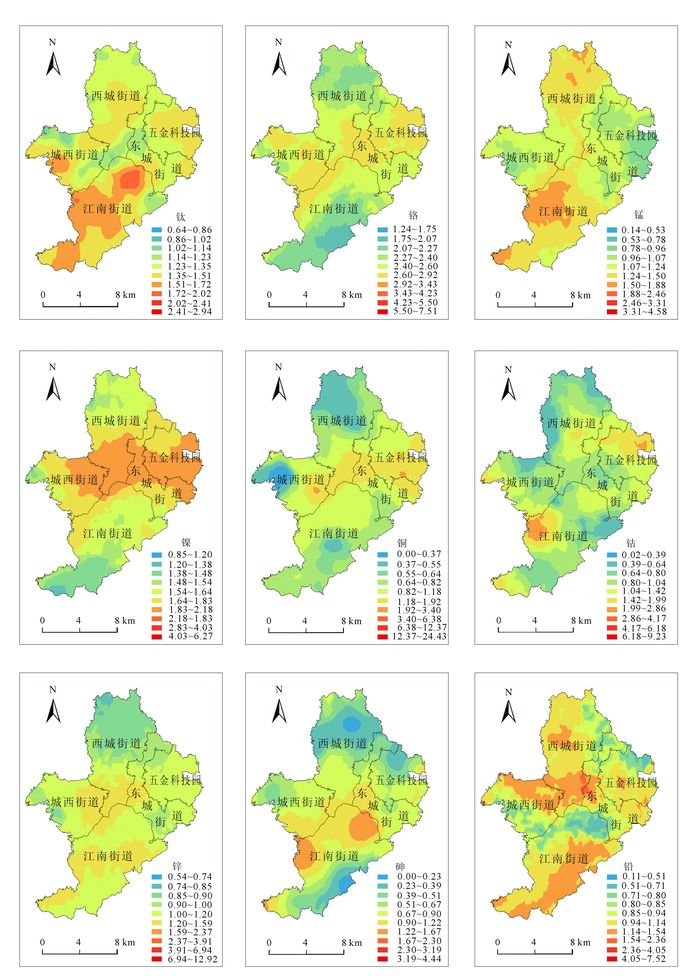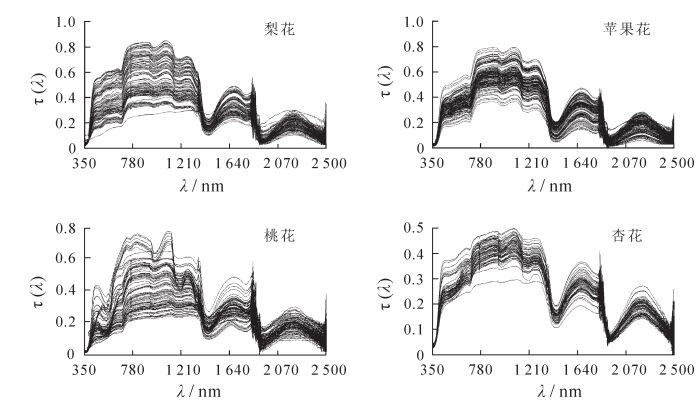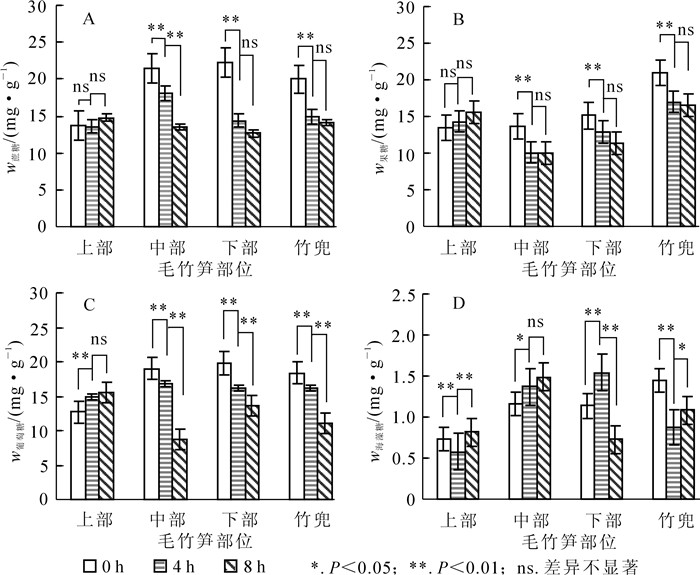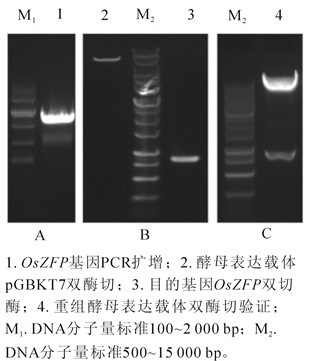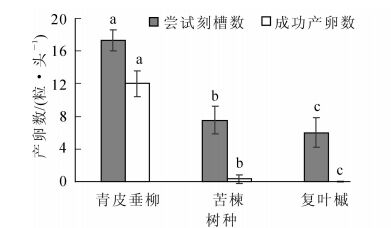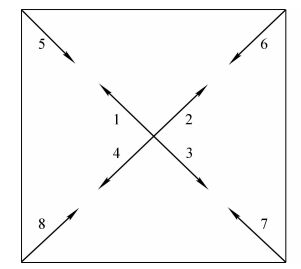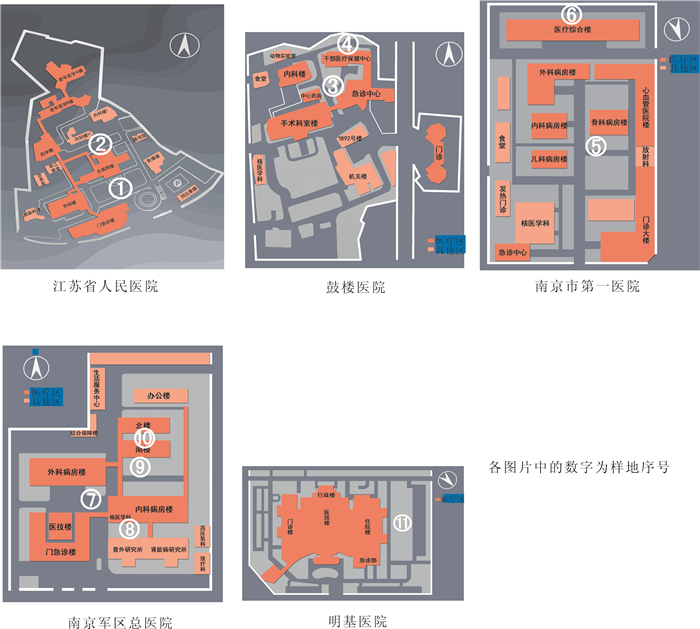2017 Vol. 34, No. 6
To reveal heavy metal pollution of the Aojiang River Basin in Wenzhou, surface sediment and riparian soil were acquired from the river totaling 62 samples in 31 groups. Heavy metal content of chromium (Cr), copper (Cu), zinc (Zn), nickel (Ni), and lead (Pb) were measured with a handheld X-ray fluorescence spectrometer (X-MET 7000). Soil background values, variance analysis, correlation analysis, and evaluation methods for potential ecological problems were used to analyze spatial distribution and potential ecological risks of heavy metals. Results showed that 1) in general, the contents of four metals other than Pb in the riparian soil and surface sediment were significantly higher than background values of heavy metals in the soil of the Wenzhou Region (P < 0.05) representing an enrichment phenomenon. Also, content of Cr, Cu, Zn, and Pb in the sediment and soil had no significant differences (P>0.05), mainly because of the tidal water reflux at the seaport, but Ni content of sediment was significantly higher than riparian soil (P < 0.05). 2) The correlation analysis showed highly significant, positive correlations for Cr-Cu (rsurface sediments=0.666, rriparian soils=0.841, P < 0.01), Cu-Zn (rsurface sediments=0.781, rriparian soils=0.688, P < 0.01) and Cu-Zn (rsurface sediments=0.831, rriparian soils=0.800, P < 0.01) between surface sediments and riparian soils and significant correlations (rsurface sediments=0.433, P < 0.05) between Cu and Ni in surface sediments. However, Pb was not significantly correlated to the other elements (P>0.05). 3) The spatial distribution analysis of elemental contents showed a highly enrichment degree of heavy metals in the sediment and soil along the river reaches. In this river basin the potential single-factor ecological risks(Eri) of these five heavy metals was below 40 and the comprehensive potential ecological hazards(IR) was below 150. There was slight pollution from tanning, printing, and electroplating industries as well as from severe human disturbances, such as domestic garbage dumping and industrial sewage drainage, so that industrial management and human disturbances around this river basin should be lessened.
To assess pollution characteristics and the degree of heavy metal pollution and to discuss the spatial distribution characteristics, the study area was divided into 500 m×500 m, according to land use types, a total of 181 samples were collected from surface soils in the main urban area of Yongkang City (the Hardware City of China), and the contents of nine heavy metals:Ti, Cr, Mn, Co, Ni, Cu, Zn, As, and Pb, were determined. Pollution was assessed by a single-factor pollution index and potential ecological risks were assessed by the Hakanson Risk Index (IR). A multivariate analysis and geostatistics were applied to examine the spatial distributions of heavy metals in the soils, each point we take 5 samples, then mixed, after pretreatment we assay the samples with 3 replications. Results showed that the mean values of Ti, Cr, Mn, Co, Ni, Cu, Zn, and Pb were higher than the natural soil background values in the Jinhua Quzhou Basin of Zhejiang (P < 0.05), but the mean value of As was below (P < 0.05). The single-factor pollution index revealed the following order:Cr > Ni > Co > Ti > Mn > Cu > Zn > Pb > As. The correlation analysis showed highly significant, positive correlations for Ni-Cu (r=0.743, P < 0.01), Cu-Zn (r=0.893, P < 0.01), Ni-Zn (r=0.652, P < 0.01). The mean value of Hakanson IR was 49.05, which indicated that the contamination level of heavy metals in Yongkang was slight in total. However, there was moderate contamination in local areas where Cu, As, and Co were at high or moderate ecological risk levels. Overall, accumulation of Cr, Ni, Cu, Co, and As were influenced by industrial production; Zn and Pb were influenced by traffic; and Ti and Mn originated from smelting and manufacturing with Ti also being controlled by parent materials. Industrial land has the highest potential ecological risk, which needs immediate attention.
To assess the heavy metal contamination in rice and human health risks induced by rice consumption in Gaohong Town, Zhejiang Province, 51 local and 37 commercial rice samples were collected and analyzed for heavy metal concentrations. This was followed by a pollution index calculation, correlation analysis, and cluster analysis. In addition, potential health risk through rice consumption was evaluated using a hazard index (IHI) based on the data and questionnaire surveys. Results showed that rice samples were contaminated by Cr, As, and Pb in Gaohong Town with concentration ranges of 0.03-13.45 mg·kg-1 for Cr, 0.01-1.64 mg·kg-1 for As, and 0.04-7.84 mg·kg-1 for Pb. Of the rice samples that exceeded the National Food Safety Standard, 70.59% were Cr, 31.37% were As, and 27.45% were Pb. The comprehensive pollution index of local rice reached 3.01, which implied a moderate pollution level. By comparison, the pollution index of commercial rice from external sources was 1.95, meaning a mild pollution level. The IHI value of local rice samples was 3.50, and for market rice samples it was 2.18. Thus, the overall health risk from heavy metals induced through local rice consumption was higher than commercial rice.
This study was to determine the changes of water status and photosynthetic characteristics in different pecan cultivars during drought stress and recovery. Pecan cultivars 'Pawnee' 'Mahan' 'Stuart' 'Mohawk' 'Jinhua' 'Shaoxing' and 'Zhongshan 25'were selected to consider indicators of photosynthetic characteristics, chlorophyll, and water use efficiency(WUE). Results showed that with prolonged drought, net photosynthetic rate (Pn), transpiration rate (Tr), stomatal conductance (Gs), relative water content (RWC) and chlorophyll content of all plants decreased. However, water use efficiency for all plants increased gradually reaching a peak on day 17. After 3 d of watering, all these parameters showed signs of recovery. The fastest recovery rates were 'Pawnee' (Pn had recovered 76.1%) and 'Mahan' (Pn had recovered 69.4%). After watering for 8 d, all tested parameters were restored to almost equivalent levels of the control (ck). Drought resistance of different pecan cultivars was in the order of 'Mahan' > 'Pawnee' > 'Shaoxing' > 'Zhongshan 25' > 'Jinhua' > 'Stuart' > 'Mohawk'.
To study the effects of drought stress on the growth of Hippophae rhamnoides in a natural environment, plant water relations and photosynthetic characteristics of two cultivars:H. rhamnoides subsp.sinensis 'Fengning' and H. rhamnoides subsp.mongolia 'Xiangyang' with different degrees of drought were studied by simulating natural soil drought conditions and water recovery processes. Results showed that leaves, experiencing drought treatment, initially shrunk at 22nd (19.40%) for the exotic species 'Xiangyang' and 33rd (11.66%) for the native species 'Fengning'. Also, 'Fengning' had stronger drought resistance compared to 'Xiangyang'. In addition, with increasing drought stress, the leaf water potential of both species decreased (0.77 and 0.45) and the moisture absorption ability increased. The maximum net photosynthetic rate, net photosynthetic rate, transpiration rate, stomatal conductance, light saturation point, and apparent quantum yield decreased with increasing drought stress; whereas, the relative content of chlorophyll and the light compensation point increased. Also, water efficiency rose after falling. The dark respiration rate of 'Fengning' treatment group decreased first and then recovered, but 'Xiangyang' treatment group was unchanged and then increased. After rehydration, the physiological indexes appeared in different degrees of recovery. Therefore, when extreme drought occurred in the process of cultivating a plantation, the leaves shrunk and need timely irrigation to avoid unrecoverable damage with 'Fengning' being more suitable than 'Xiangyang' as a breeding parent.
To establish an effective model for fruit tree species identification at the flowering stage, spectral data of four kinds of fruit trees were collected using an ASD FieldSpec 3 full band portable spectrometer. Nine sensitive and characteristic bands of the spectrum (370 nm, 395 nm, 541 nm, 590 nm, 682 nm, 720 nm, 1 268 nm, 1 839 nm, and 2 481 nm) and two vegetation indices for accurately detecting fruit tree species were first obtained using the Successive-Projections-Algorithm (SPA) method. Subsequently, some classification methods were applied, such as Partial Least Squares Discriminant Analysis (PLS-DA), Orthogonal Projection to Latent Structure Discriminant Analysis (O-PLS-DA), and Back Propagation (BP), to compare their effectiveness for distinguishing fruit tree species. Choice 30 m×30 m standard rural area in the garden, select 10 trees of every 4 fruit tree species and every tree select 3-4 points using optional bolting method. 10 spectra were measured and take the average at every point, repeated three times. Results showed that the average detecting accuracy for PLS-DA was 73.36%, for O-PLS-DA was 81.82%, and for BP was 93.90% with the BP model having the best prediction accuracy for clarifying fruit tree species. This study demonstrated the feasibility of implementing hyperspectral imaging from near infrared spectra technologies (NIST) for identifying fruit tree species during the flowering period.
To discuss expression of the PeTPS1/PeSnRK1 gene and soluble sugar mass fraction in different parts of Phyllostachys edulis bamboo during the process of rapid growth and to clarify their relationship with this rapid growth, the relative expression of PeTPS1 and PeSnRK1 in the bamboo stump and the lower, middle, and upper parts of the Ph. edulis bamboo shoot were analyzed at sunset (0 h), 4 h, and 8 h after sunset using the quantitative reverse-transcriptase polymerase chain reaction (qRT-PCR) analysis technique. Also, the mass fraction of soluble sugars was analyzed by the kit method. Results showed that the soluble sugar mass fraction in the upper part of the bamboo shoot did not change. The mid-section of the bamboo shoot mass fraction at 8 h after dusk compared to sunset was lower 2.2 times for glucose, 1.4 times for fructose, and 1.6 times for sucrose. Nutrient storage mass fractions in the bamboo stump at 8 h after sunset compared to 8 h after sunset was lower for glucose (1.6 times), fructose (1.3 times), sucrose (1.4 times), and trehalose (1.3 times). Expression of the PeTPS1 gene in the middle of the bamboo shoot was 4.8 times lower than in the lower part of the bamboo shoot. Expression of the PeSnRK1 gene in the bamboo stump compared to the other parts was higher at 8 h after sunset and was 1.7 times higher compared to dusk. These results could provide new insights into the mechanism of rapid growth of Ph. edulis as well as direct fast-growth and breeding of other trees.
OsZFP, a CCHC-type zinc finger protein, has reportedly participated in lateral root development in rice. To determine the molecular mechanism and its interacting proteins in a regulated network, the OsZFP gene from Oryza sativa. 'Nipponbare' was cloned, and then a yeast bait vector, pGBKT7 + OsZFP, was constructed by EcoRⅠ and SalⅠ for cDNA library screening of rice. Results showed no toxicity or autoactivation with transformation of the Y2H strain containing the pGBKT7 + OsZFP bait vector. In a yeast two-hybrid assay, a positive interacted protein was obtained and confirmed from the cDNA library. Sequencing and homologous alignment from the National Center for Biotechnology Information (NCBI) showed that the interacting protein (named chaperonin containing a T-complex polypeptide 1 (TCP-1) eta subunit, CCT-eta) was the eta subunit of the chaperone which contained a TCP-1 domain. Based on the interaction between OsZFP and the CCT-eta subunit, it was speculated that the CCT-eta subunit of the chaperone protein may be involved in controlling lateral root development in rice.
To find the main influencing factors of wind resistance in Eucalyptus camaldulensis and to select excellent high-yielding and wind-resistant families for production, this research, based on a three-year successive study of 114 E. camaldulensis provenance families, selected 50 of the families as the study material. Growth traits (tree height, diameter at breast height-DBH, and individual volume), wood properties (wood density, fiber length, fiber width, and ratio of fiber length to width), non-destructive wood traits (Pilodyn penetration value and stress-wave value), and wind damage indexes were measured and analyzed using SPSS and Genstat 7.0 Statistics. Results showed that differences in traits were highly significant (P < 0.01), except for DBH (P=0.062), ratio of fiber length to width (P=0.636), and bark thickness (P=0.174). Single stand heritabilities were 0.046-0.885, and family heritabilities were 0.077-0.777; fiber width(0.684), tree height(0.590), wood density(0.643), and stress-wave value(0.777) also had high heritability. The range of phenotypic variation coefficients was 5.11%-87.57%; coefficients of genetic variation were 1.78% to 34.57%; and coefficients of environmental variation were 4.43% to 80.74%. The variation of wind damage index and individual volume was higher, which was help to the selection of excellent wind-resistant families. The correlation analysis was significant between fiber length and wood properties (wood density (r=0.234), Pilodyn penetration value (r=-0.169), and stress-wave value (r=-0.514)), and also between fiber width and growth traits (tree height (r=-0.253), DBH (r=-0.323), and individual volume bark thickness (r=-0.323)). Meanwhile, wind damage indexes were significantly correlated to tree height (r=-0.607), individual volume (r=-0.346), stress-wave value (r=-0.123), and bark thickness (r=-0.120), but not to wood fiber length, ratio of fiber length to width, DBH, Pilodyn penetration value, or wood density. The genetic relationships among wind damage index and tree height, individual volume were higher than the other characters. Using the comprehensive estimate method, five families:2007, 2006, 20027, 2005, and 2008, with favorable growth and wind resistance as well as genetic gains ranging from 0.53 to 22.39 were selected.
Phytohormones are an important factor in regulating adventitious root formation. To provide a reference for discussing the role of phytohormones on adventitious root formation in walnut, the effect of exogenous hormones on endogenous hormones was analyzed by measuring the level of endogenous hormones during the cutting process of a rejuvenated softwood, Juglans(walnut) 'Zhongningsheng'. The rejuvenated softwood was first induced by exogenous indole-3-butyric acid (IBA) and then, using High Performance Liquid Chromatography-Mass Spectrometry (HPLC-MS), the endogenous hormones:Indole-3-acetic acid (IAA), Gibberellic acid (GA3), Abscisic Acid (ABA), and Zeatin (ZT); basal segments of soft-cuttings were measured followed by measurement of the rooting situation, student's test were used for the treatment of the data. Results showed strong differences between samples induced and not induced by IBA. The rooting rate of rejuvenated softwood induced by IBA was up to 98.1%; whereas, in the control the rooting rate was 0 and the mortality rate was 75.5%. The rooting process experienced several stages, such as thickening of the cambium, meristem cell formation, root primordia initial cell formation, root primordia formation, and root development through observation of the anatomic structure. Additionally, the external morphology showed thickening and cracking. During softwood cutting, endogenous hormone levels in rejuvenated soft shoots induced by IBA changed noticeably. Also, IAA increased first and reached its peak at day 5, then decreased as did GA3. However, ABA decreased first and then increased. In the early stages, ZT changed little but did increase after root primordia induction. The level of IAA in softwood induced by IBA improved; however, the effects on ZT were small. So the changes of endogenous hormones induced by IBA promoted adventitious root formation.
To analyze the effect of different substrates (S) on growth as well as nitrogen (N) and phosphorus (P) status in the three kinds of trees, two-year-old container seedlings of Phoebe chekiangensis, Cinnamomum chekiangense, and Taxus wallichiana var.mairei were used as the objective material. The seedlings were cultured in substrates S1 (45% peat, 40% rice husk and 15% mud) and S2 (35% peat, 40% rice husk and 25% mud) with single factor randomized block design. Three replications for them were carried for each treatments. And their growth data for the two treatments were tested by T test analysis in SPSS 18.0. Results showed that P. chekiangensis cultivated with S1 grew better than S2 with height of 88.91 cm (6.61 cm larger than S2) (P=0.034) and stem biomass of 23.35 g (3.39 g larger than S2) (P=0.020). Compared to S1, growth of C. chekiangense and T. wallichiana var. mairei cultivated with S2 was better with diameter at ground 1.3 m of 9.08 mm (larger by 11.5%) (P=0.020) and stem biomass of 9.21 g (larger by 27.2%) (P=0.040) for C. chekiangense; whereas, for T. wallichiana var. mairei, biomass was 29.70 g (larger by 22.7%) (P=0.010). The effect of S2 on root length (P=0.010), root surface area(P=0.002), root diameter(P=0.001), and root volume(P < 0.01) for T. wallichiana var. mairei was larger than S1 by more than 34.5% for each factor. With S2 the N (489.66 mg) (P=0.001) and P (26.86 mg) (P=0.001) content of C. chekiangense, and the N (559.13 mg) (P < 0.001) and P (42.81 mg) (P < 0.001) of T. wallichiana var. mairei were higher than that of S1. However, nutrition absorption of P. chekiangensis did not display differences between the substrates. So, for large container seedlings of these three precious trees, according to both growth and nutrition absorption results, P. chekiangensis would grow better cultivated with S1 which contains more peat and less mud; whereas, C. chekiangense and T. wallichiana var. mairei should be planted with S2 which contains less peat and more mud thereby taking into account the special characteristics of each tree.
To improve the forest production mode of Cunninghamia lanceolata artificial and natural forests in Hunan Province, their height-diameter curves were studied. Based on periodic inventory data of C. lanceolata in Hunan, six common empirical models were used to fit height-growth and diameter-growth curves, and selected the best one from them. On the basis of the optimal model, differences in stand origin were considered and compatible height-diameter curve equations for a group of stands with different stand origins were built by introducing dummy variables and using the measurement error model method. These growth status for stand in different origins were compared and analyzed by drawing scatter plots. Results showed that the fitted coefficient of determination for the C. lanceolata height-growth model with the dummy variables was better than this without dummy variables. The fitted coefficients for the tree diameter-growth curve was 0.820 5 with prediction accuracy of 98.30%, and for tree height was 0.758 0 with prediction accuracy of 98.01%. Also, DMAD and ERMSE indicators were superior to the traditional methods. The growth progress of C. lanceolata artificial and natural forests were the same; however, in the young stage, tree height and diameter growth rate of the artificial forest were higher than the natural forest. Moreover, tree height and diameter in the artificial forest reached a maximum value earlier than in natural forests. In conclusion, the model of tree height growth was established using the model with dummy variables, which not only improved the accuracy of the model but also solved the problem of incompatibility between models.
Anoplophora glabripennis (Motschulsky) have a wide range of host plants and endanger both of the health host and the stressed host. In order to find the plant volatiles which affect oviposition behaviors and lay the foundation for the development of green attractant of A. glabripennis. The oviposition preference of three host plants, Salix ohsidare, Melia azedarach and Acer negundo, was tested by laboratory the selective and no-selective oviposition test. The volatile components of three host plants were analyzed by the method of dynamic headspace adsorption to combine Gas Chromatography-Mass Spectrometry (GC/MS). The results of both the selective and the no-selective test showed that S. ohsidare was the most suitable for ovipositing by A. glabripennis, followed by M. azedarach, and finally A. negundo. The success rate of oviposition of A. glabripennis on S. ohsidare was 69.4%, and the one on A. negundo was 0. The results of host volatiles analysis showed that 16 compounds were found in S. ohsidare, and 11 compounds were detected in M. azedarach and A. negundo. 3-Carene and 2-ethyl-Hexanal only tested in S. ohsidare. The contents of nonanal, styrene, and acetophenone in S. ohsidare were significantly higher than M. azedarach and A. negundo. In the above five compounds, 3-carene and nonanal were reported to show the attraction on A. glabripennis, so we speculate that 3-carene and nonanal may be the effective components for attracting oviposition of A. glabripennis females.
The family of myogenic regulatory factors (MRFs) played an important role in the process of skeletal muscle differentiation during the embryonic stage and the early stage of hatching with Pax3 and Pax7, two transcription factors of the PAX family, guiding the formation of various processes during the growth and development of muscle fiber. To determine the expression profiles of these genes during the embryonic and muscle development stages in geese, the expression pattern of MRFs, Pax3, and Pax7 during the embryonic period (7th, 11th, 15th, 19th, 23th, 27th day in embryonic (E) age) and early birth (7-day-age) in Zhedong White Geese was studied. Analysis included extracting RNA and synthetic DNA along with real-time PCR followed by further analysis on their relationship with the development of breast and leg muscles. We took three samples for tissue of each period, and the significance of expression was analyzed with SASS. Results revealed that MRFs, Pax3, and Pax7, were all related to the development of skeletal muscles in geese with different expression patterns. MRFs and Pax7 showed peak expression during the period from E11 to E15, and the highest expression of Pax3 with a declining expression appeared at E7. Findings suggested that the expression patterns of these genes were highly matched with their function during muscle development and provided a theoretical basis for further investigation of the regulatory mechanism of MRFs, Pax3, and Pax7 during skeletal muscle development in geese.
Strain TJB-8 has been isolated from the root soil of poplar and has exhibited a strong inhibitory effect against Cytospora chrysosperma, a predominant fungus causing poplar canker. In order to provide technical guidance for further exploitation and utilization of TJB-8, the species of TJB-8 and its antifungal substances were investigated in this study. The strain TJB-8 was identified based on morphological and physiological characteristics, as well as a phylogenetic analysis of partial 16S rDNA sequence; the antifungal substances of TJB-8 were analyzed by colony diameter assay and two-compartment plate method. Results revealed that sterile culture filtrates of TJB-8 had a strong antifungal activity against C. chrysosperma with an inhibitory rate of 97.42% (over 72 h). The hyphae of C. chrysosperma at the edge of the colony exhibited swelling after being treated with a sterile culture filtrate. Also, this sterile culture filtrate effectively inhibited the hyphae growth of Colletotrichum gloeosporioides, Alternaria tenuissima, Fusarium oxysporum, Fusarium graminearum, and Rhizoctonia solani. Strain TJB-8 was identified as Bacillus cereus and produced β-1, 3-glucanase and protease. Moreover, TJB-8 produced high antifungal activities against C. chrysosperma with crude proteins (100% in 72 h), lipopeptides (100% in 72 h), and volatiles (76.08% in 48 h). Thus, B. cereus TJB-8 was an antagonistic bacterium with strong antifungal activity, a wide inhibitory spectrum, and varied antifungal substances, having a broad prospect of industrial development and field application as a biological fungicide.
This study was undertaken to determine the regulation of runoff and sediment yield on slopes with typical plant cover measures and the influence of rainfall on soil moisture for slope-land in rocky areas of the Taihang Mountains. Based on standard runoff plot observations in the Baima Small Watershed in Pingshun County, Shanxi Province, runoff and sediment yield on slopes with typical plant cover measures for different rainfall patterns and rainfall intensities were compared. Analysis of changes in soil moisture content for each slope with bare land as a control was conducted with statistical analysis methods. Results showed that 1) heavy rain and rainstorms were the main rainfall patterns causing soil and water losses. With moderate rainfall intensity and high rainfall intensity, runoff and sediment yield of runoff plots on slopes accounted for up to 71.94%-73.60% of the total runoff and 80.78%-90.35% of the total sediment. 2) With various patterns of rainfall, runoff and sediment yield on slopes with different cover patterns were bare land > natural slope > artificial grasses > shrubs > forest. 3) The slope runoff plots for changes in soil moisture were identical with and rainfall distribution being consistent. Thus, shrub and forests could effectively control soil and water loss in this area with soil moisture changes being strongly influenced by rainfall.
The composition and evaluation of the plant community characteristics and stand spatial structure are the keys to the forest park landscape, and are of great significance to the optimization and promotion of forest park landscape. The research took Jinsiwan Forest Park in Fujian Province as the research object, and selected 40 typical samples and 24 factors to reflect the community characteristics and stand spatial structure. The scenic beauty estimation value of each sample was calculated by using scenic beauty estimation (SBE) method to construct a multiple regression linear model and landscape evaluation and prediction between SBE and various influencing factors categories, and analyze contributions of plant community characteristics and stand spatial structure to landscape aesthetics quality of forest parks. The findings indicated that the main factors affecting SBE included litter, uniformity of ground plants, abundance of conifer, crown density, variation coefficient of diameter at breast height (DBH), competition index, under branch height and uniform angle index, accounting for 20.809 per cent, 20.424 per cent, 14.547 per cent, 14.162 per cent, 10.790 per cent, 8.189 per cent, 6.455 per cent and 4.624 per cent respectively. The contribution rates of community characteristics and stand special structure were 87.187 per cent and 12.813 per cent. The research further explained the important roles of plant community characteristics and stand spatial structure in the scenic beauty estimation of forest parks.
To analyze temporal and spatial evolution for ecological risk and landscape patterns in a lake basin so as to further improve the ecological environment, Puzhehei Lake basin in Yunnan Province was studied over(1990, 1995, 2000, 2005, 2010, and 2015). Analysis included using the spatial analysis function of ArcGIS based on the landscape disturbance index and the landscape loss index to constructed a landscape ecological risk index. Results showed that:(1) For landscape patterns from 1990 to 2015, the degree of disturbance for agricultural land and woodlands was the most intense, while that of building land, gardens, and wetlands was slightly weaker, and that of unused land was the weakest with the interference degree index ranged from 0.208 7 to 0.218 0. In addition, the variation range of disturbance index for agricultural land was quite narrow (from 0.375 8 to 0.379 6), whereas that for construction land fluctuated largely with a changing rate of -14.10%. (2) For twenty years (from 2005 to 2015), the degree of landscape loss for different land-use varied markedly. The index of landscape loss for farmland and unused land was the largest with the values of 0.542 2 and 0.551 4, respectively, whereas that for wetland, construction land, and forest land take the second place, and that for garden land was the smallest (0.119 7). (3) From 1990 to 2015, the spatial distribution of ecological risk changed largely, and it showed a low level of ecological risk between 1990 and 2005 whereas a middle level from 2005 to 2015. In addition, the ecological risk was slowly increasing in the range of research period. The spatial and temporal distribution of ecological risk was closely related to the intensity of land use and human activities; therefore, regional sustainable development could be realized by strengthening the integrated management of land and human activities and by promoting a synergistic effect among social, economic, and ecological protection activities.
The landscape has a supporting role to the medical effect. A synthetic evaluation system on out-door environment should be constructed through scientific and quantitative methods to build hospital outdoor environment which helps patients recover. Taking 5 first-class general hospitals in Nanjing as research subjects, the research used the methods of Analytic Hierarchy Process and the Fuzzy Synthetic Evaluation to construct synthetic evaluation system of hospital out-door environment. The results indicated that functional indicators were the most important, among which the environmental safety indicator had the highest weight value of 0.456 6. Among the suitability indicators, 'soft' elements such as acoustical environment, wind environment and luminous environment had high weight values which were 0.365 0, 0.255 3 and 0.182 9 respectively. In ornamental indicators, green looking ratio had the highest weight value of 0.532 7, much higher than other indicators. Based on the above synthetic evaluation system of outdoor environment, the research obtained grade levels of outdoor environment quality of the sample hospitals, which showed that outdoor environmental quality of the general hospitals in Nanjing was relatively low. The research showed that quantitative and synthetic evaluation system was more scientific and objective in out-door environment evaluation, and therefore provided a significant reference for the construction of hospital outdoor environment.
Sustainable development of tourism in forest areas is based on the urban-rural interaction. It is conducive to China's ecological environment, solving the problem of surplus labor and increasing workers' income in forest areas. It has a great impact on the development of regional economy. Based on the site research and expert questionnaires, this paper established a comparatively complete index system for the sustainable development of tourism in forest areas. Combined with the AHP to define the weight of each factor and adopted a multi-objective linearly weighted function model to conduct a comprehensive evaluation of development phases of tourism in forest areas. The research evaluated nine forest farms in Yichun City, Heilongjiang Province, to test the practicability and systematicity of the index system, and improve its applicability, hence providing reference for further improvement of the development of tourism and ecological environment in the northeast forest areas.
Because local participants of an urban greening project were not the decision makers for tree species selection, the initial tree distribution in an urban green space was completely controlled by artificial selection resulting in problems such as concentration of dominant tree species, simple structure, and low ecological benefits. To show that inclusion of local participants was very important in remedying problems of urban tree species selection, in this study, influential factors for urban tree species selection were picked and an evaluation index system was established with input from government employees, designers, green development enterprises, suppliers, and the public. Then a correlation analysis between these local participants was analyzed by SPSS, and a comprehensive evaluation on common tree species from the point of view of these local participants was accessed using Hefei City as the test site. Results showed that (1) judgment of urban tree species selection influential factors differed among the local participants. (2) Evaluation data of weighted values for urban tree species selection between government departments and designers was highly significant (P=0.01) and was correlated (r=0.852) and between government departments and green development enterprises was significantly correlated (P=0.05, r=0.590). (3) According to the weighted values, the comprehensive evaluation of common landscape tree species in Hefei City was accessed with 155 tree species scoring above 3.0 being selected. This classification provided new ideas and suggestions on urban tree species selection.
Forestry production efficiency is an important issue in the development forestry economics. Measuring and analysing the efficiency of forestry production scientifically, which reflect truly the actual situation of forestry production efficiency to provide a scientific basis for improving forestry production efficiency. This paper forecasted and evaluated bamboo production efficiency using the three-stage Data Envelopment Analysis (DEA) model. The dataset adopted in the study was first hand data, collected based on 110 surveys from 6 administrative villages in Anji County in Zhejiang Province. The results showed:Among the environment variables, significant negative effects were found for factors such as the years of education for the householder, income ratio for bamboo production compare to total income, the number of family members engaged in the production of bamboo, the total size of land for bamboo production; while the following elements showed significant positive effects for bamboo production:age of household head, involvement in technical training in bamboo production, and certificate of forestland. After excluding the impact of environmental effects and random errors, this studies found that the sample household bamboo production average technical efficiency value showed a significant decreased, from 0.537 to 0.436, while the average pure technical efficiency value from 0.602 to 0.803, and the average scale efficiency value decreased from 0.891 to 0.556. At the same time, increasing return to scale was witnessed for bamboo production. Based on the above analysis, suggestions, such as reduce the fragmentation of bamboo forestland, guide farmers to allocate bamboo production factors rationally, clarify the property rights of bamboo forestland, strengthen technical training for farmers' bamboo production, are put forward.
Root exudates are the carrier of material exchange between plant and rhizosphere, which are also involved in phytoremediation of contaminated soil links. The classification basis, methods applicability and remediation effects of root exudates in soil were reviewed among the literature of China and abroad in 1992-2016 in present paper. Through the systematic analysis on the extraction and identification methods of plant root exudates and its effect on contaminated soil remediation mechanism, the present research system and breakthrough in the future was revealed. Phytoremediation is a green and environmental remediation technology, and which was used widely in recent years. However, low efficiency and long time-consuming were its important bottleneck. The key to solving these problems is to accelerate the study of the role of root exudates in phytoremediation. Through the analysis of the previous research literature in this field, the physical, chemical and biological effects of root exudates were clarified systematically, which provide theoretical support technical guidance for the study of phytoremediation of heavy metal contaminated soil in the future.
To determine the effect of drought stress on cucumber histological structure, the Cucumis sativus 'Jinyou No.1' seedlings were cultured in a nutrient solution under drought stress simulated by 5% and 10% PEG-6000. Results showed that the degree of deformation in the structure of cucumber seedlings gradually intensified with an increase in the degree of drought stress and differed compared to normal seedling growth. The 5% PEG-6000 treatment decreased the number of root cortex parenchyma cells, stem xylem conduit atrophy, and more closely arranged the leaf palisade tissue. With the 10% PEG-6000 treatment, cucumber seedlings showed serious deformation, shrinkage, disordered arrangement, and broken skin in the tissues and cells. To a certain extent cucumbers could adapt to mild drought stress through a change in histological structure; however, with severe drought stress the organizational structure suffered damage ultimately resulting in a loss in function of organs, tissues, or cells. This study provided a reference for screening drought-tolerant varieties and for drought cultivation of cucumber.
To determine the effect of soil cover with rhizome controlling cultivation on growth of Phyllostachys prominens, an excellent shoot and timber used bamboo species ecologically well adapted to its habitat, and to provide guidance for sustainable bamboo management, leaf traits as well as the content of leaf carbon, nitrogen, and phosphorus for 1-3 year-old Ph. prominens of soil cover with rhizome controlling cultivation and normal cultivation were studied. Furthermore, leaf morphology and nutrient stoichiometry were also analyzed. Results showed that 1-3 year-old Ph. prominens leaf of soil cover with rhizome controlling cultivation stand tended to be narrow and long with leaf area and specific leaf area increasing (P>0.05); whereas, leaf mass and thickness decreased slightly(P>0.05). Between soil cover with rhizome controlling cultivation and normal cultivation, there were no differences (P>0.05) for the same above mentioned leaf traits. However, leaf C content greatly increased (P < 0.05), N content increased slightly (P>0.05), and P content decreased a little (P>0.05). Also, C/N and N/P increased slightly (P>0.05) with C/P being greatly enhanced (P < 0.05). These results indicated that soil cover with rhizome controlling cultivation resulted in slight variation of leaf morphological plasticity for Ph. prominens and showed that with photosynthetic C fixation and nutrient utilization efficiency increasing, high and stable production of superior quality bamboo shoots could be promoted.





